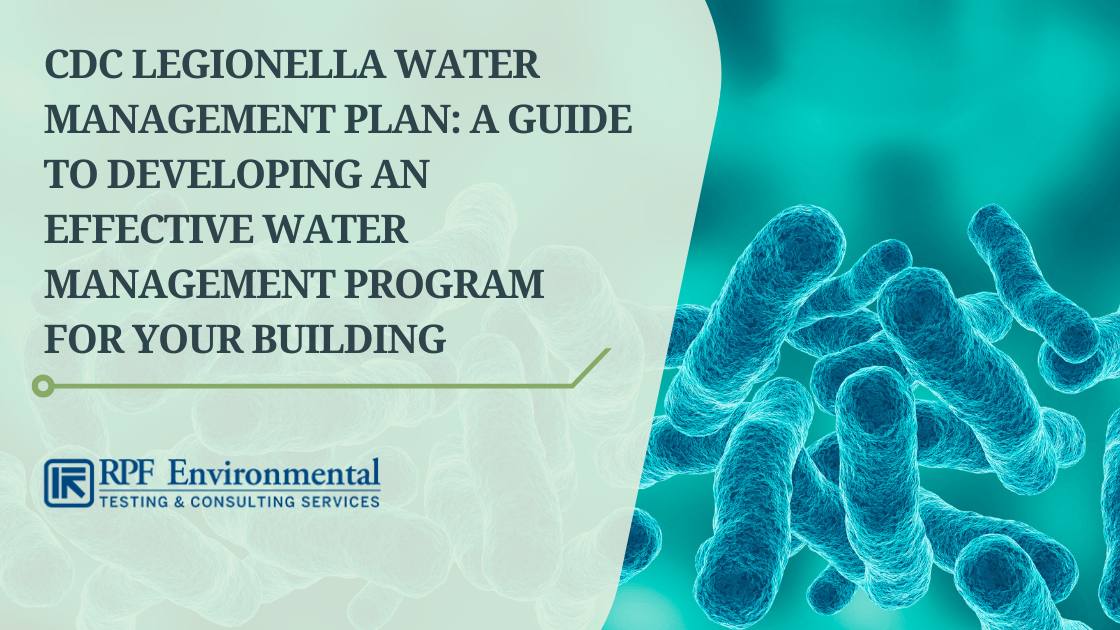Develop and implement an industry-standard Legionella water management program to effectively prevent Legionellosis including Legionnaires’ disease in your building.
CDC provided a toolkit for developing a Legionella water management program to help building owners and managers as well as healthcare facilities control the spread of Legionella in their water systems. This guide will give you the most important things you need to know about CDC Legionella water management plans and how to develop one in accordance with ASHRAE Standard 188.
Key Takeaways
- The best way to prevent Legionnaires’ disease in your building is to minimize the risk of Legionella growth through a water management program.
- You should tailor your water management plan according to your building’s specific needs.
- Schools, commercial buildings, and healthcare facilities with complex water systems need to develop and implement a Legionella water management plan.
- The key elements of a Legionella water management program include a water management team, risk assessment, established control measures and limits, and corrective actions to take.
- Maintaining proper water temperatures, preventing stagnant water, adequate disinfection, and proper device maintenance help in preventing Legionella growth effectively.

RPF Environmental has certified experts who can help you develop, implement, and operate your own Legionella water management plan at the best prices. We also perform Legionella testing in Illinois, Indiana, Maine, Massachusetts, New Hampshire and other areas across the country. Book an appointment now!
What is a Legionella Management Program?
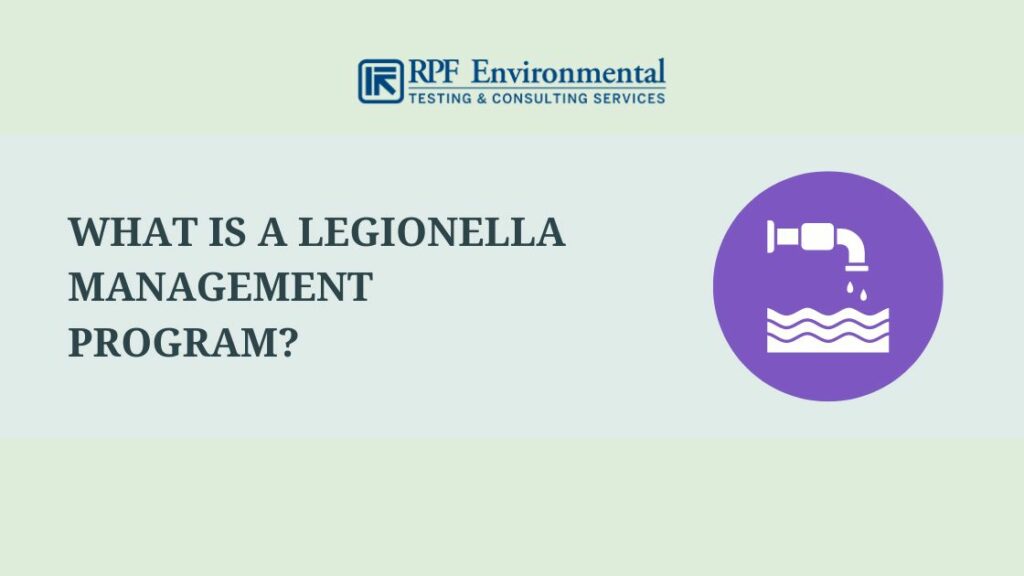
A Legionella water management program:
(1) Identifies hazardous conditions in water systems that promote the growth of Legionella bacteria; and
(2) Outlines detailed steps to manage and minimize the spread of the bacteria
Importance of Developing a Water Management Plan For Legionella & Legionellosis Disease Prevention
Source: CDC, Legionella and Legionnaires’ Disease
The primary purpose of implementing a Legionella water management plan is to prevent Legionnaires’ disease in your facility by controlling hazardous conditions. People can get Legionnaires’ disease by breathing in small water droplets or ingesting legionella-contaminated water. Thus, building owners should develop and implement a comprehensive water management plan to combat the spread of Legionella in their water systems.
Who Needs to Create a Water Management Program?
Schools and commercial buildings with complex water systems should implement a water management program to prevent Legionella transmission in their building. CDC also encourages healthcare facilities, especially nursing homes and hospitals, covered by the ASHRAE Standard 188 to develop water management plans.
To determine which buildings and devices need a water management program, you can use CDC’s worksheet.
In summary, you need a water management program if any of the following is true:
- Patients stay overnight in your healthcare facility
- You treat or house people who are immunocompromised or with acute and chronic medical conditions in your building
- The building primarily houses people above 65 years old (e.g. retirement homes)
- The building is a hotel, high-rise apartment complex, or other multiple housing unit that has a centralized hot water system
- The building has over 10 stories
- The building has a cooling tower, hot tub that you don’t drain after each use, decorative fountain, or centrally-installed humidifiers, air washers, atomizers, or misters
If none of the above is true, it is highly recommended that you still maintain your water systems according to your manufacturer’s recommendations.
7 Key Elements of a Legionella Water Management Program: What Are the Steps to a Water Management Plan?
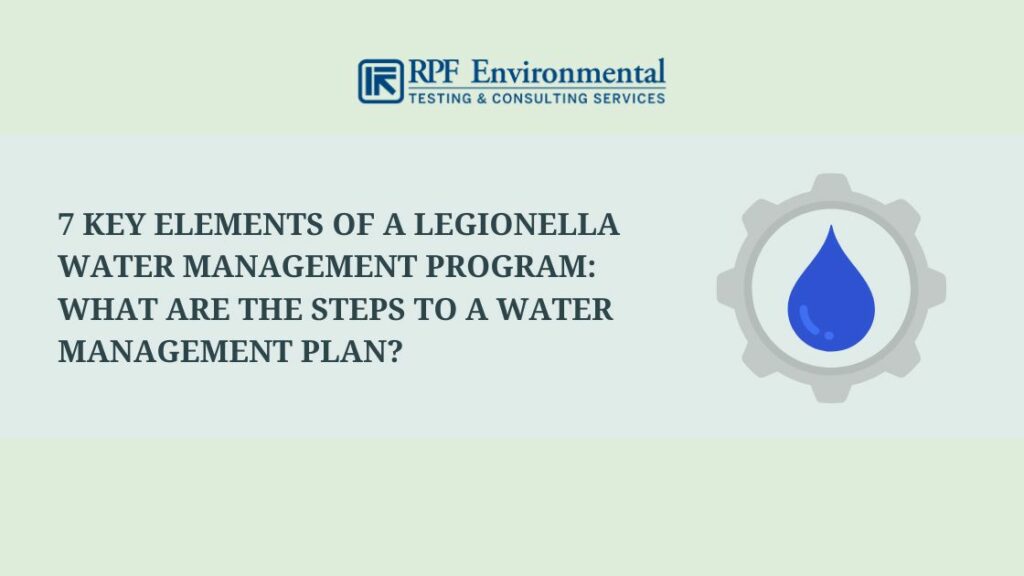
The CDC Legionella toolkit mentioned seven key elements that Legionella water management programs should have:
#1 Establishing a Team for Your Water Management Plan
The team should consist of professionals who have the right skills to help in developing and implementing an effective water management program. They should be familiar with your water system and able to:
- Pinpoint control locations and limits
- Identify measures to minimize Legionella growth
- Monitor at-risk areas
- Take corrective actions in case problems are found
You can train your own employees or hire Legionella experts outside.
A Legionella water management team typically consists of the following as per CDC’s recommendations:
- Building owners
- Buildings administrators/managers
- Engineering/maintenance employees
- Safety officers
- Chemical/equipment suppliers
- Consultants/contractors (e.g. water treatment experts)
- Microbiologists
- Environmental health specialists
- Certified industrial hygienists
- Health officials
As for healthcare facilities, include someone who is:
- Well-versed on licensing requirements and accreditation standards
- Experienced in preventing infections
- A clinician who is experienced in infectious diseases
You should also include staff for quality and risk management.
In addition, it is best to assign a team manager and identify the specific roles and responsibilities of each member. Hiring independent professionals outside can also contribute greatly to your program’s success as they can provide expert recommendations that meet industry standards.
#2 Describing Your Water Systems
Describe your water system in detail through text and a flow diagram.
When writing the description through text, you can use existing plumbing system diagrams as a basis. Also, include details on where water is entering, heated, distributed, and discarded as well as where the following components are located:
- Pools
- Water heaters
- Boilers
- Hot tubs
- Decorative fountains
- Showers
- Sinks
- Cooling towers
- Sanitary sewers
- Kitchen appliances
- Hot water storage
- Other areas of potential concern like dead legs
Consult your team (specifically your engineering and maintenance employees) regarding your building’s piping configurations to make sure that all components are covered.
For healthcare facilities, include relevant details on clinical support and patient care areas along with components where patients can get exposed to contaminated water.
As for the flow diagram, turn the text description into a simple diagram that all team members can easily understand. You don’t need to make it as detailed as building plans.
NOTE: The water system description should reflect changes in your water system and is subject to constant revision.
#3 Identifying Areas at Increased Risk (Hazard Analysis)
The next step is to assess potential hazards in your water systems, also called Legionella risk assessment, that could promote the growth and spread of Legionella. Use the flow diagram you’ve created to point out vulnerable parts of your water systems and potentially hazardous conditions that you would need to address.
These hazardous conditions can include:
- Temperatures where waterborne pathogens can grow
- Stagnation
- Areas with no disinfectant
- Other external hazards such as renovations, scheduled maintenance, equipment failure, etc.
Additional considerations for healthcare facilities include:
- Areas that may cause exposure to water droplets during medical procedures (e.g. hydrotherapy)
- Intensive care units
- Oncology floors
- Bone marrow transplant units
- Other areas that pose a high risk of infection
#4 Deciding Where to Apply Control Measures & How to Monitor Them
You should address each hazardous condition individually by establishing:
- Control Measures – actions to control the risk of Legionella growth and spread; and
- Control Limits – acceptable minimum, maximum, or range of values such as disinfectant and temperature levels
Examples of Control Measures
- Cleaning visible biofilm on surfaces
- Adding disinfectant
- Heating
- Measuring water quality throughout your system
- Maintaining water heaters at the right temperatures
- Testing patients with healthcare-associated pneumonia for Legionnaires’ disease
After establishing control measures, monitor them to ensure that they are within the limits you’ve set. You might need to monitor common changes in your water system more frequently.
Examples of Ways to Monitor Your Control Measures
- Visual inspection
- Checking temperature and disinfectant levels
#5 Determining Corrective Actions When Monitoring Results Go Outside of Control Limits
Examples of corrective actions you can take when control limits are not met include the following:
- Cleaning fountains that have slime growing on their walls, refilling them according to the program’s procedures, and checking disinfectant levels
- Preventing stagnation in building floors that are being renovated through daily flushing and monitoring chlorine and temperature levels more frequently
#6 Verify if Your Program Is Running Properly & Validate Its Effectiveness
- Verification – Establish procedures to verify that that team is doing their responsibilities and implementing the program as designed.
- Validation – Establish procedures to validate the effectiveness of the program in controlling hazardous conditions in your water systems.
It is best to hire a professional environmental testing company to test for Legionella in your building to confirm your program’s effectiveness.
#7 Documenting & Communicating All Activities
Write down your Legionella water management program and document all aspects carefully including all of the details in #1 through #6. Lastly, notify building occupants in addition to your employees about the program.
NOTE: Check the CDC’s Legionella water management program toolkit for more special considerations for healthcare facilities.
How Do You Develop an Effective Legionella Water Management Plan?
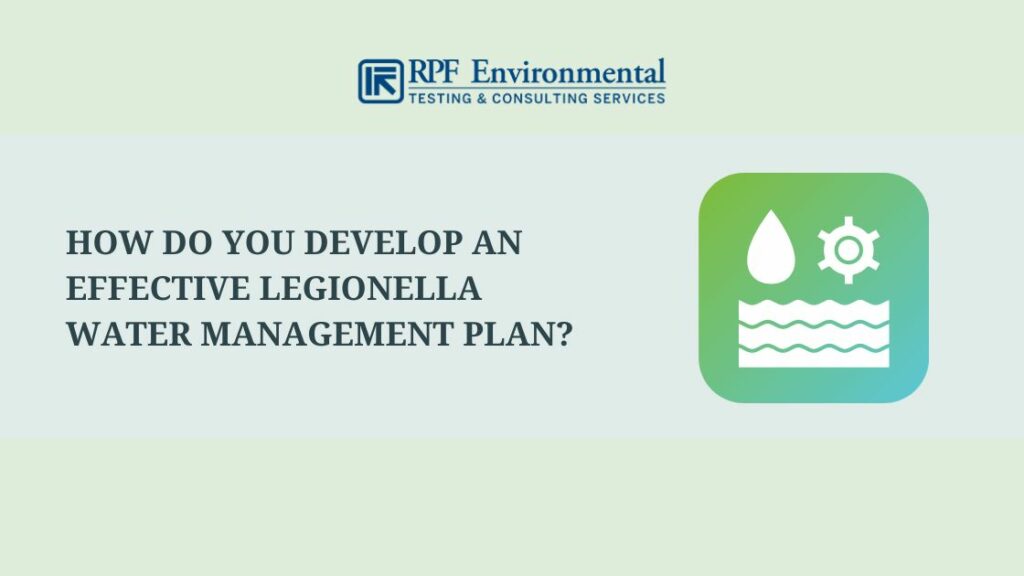
To ensure that you’ll have an effective water management plan for Legionella, it is important to train your water management team. Training equips them with the knowledge they need regarding the proper development and implementation of a water management program.
Below are the general principles of an effective water management plan according to the CDC:
- Ensuring that water temperatures are at levels where Legionella won’t grow
- Preventing stagnant water
- Making sure that you are disinfecting adequately
- Maintaining components to prevent slimy growth, corrosion, scale, and sediment
Your water management program should also be tailored to your building’s specific needs.
When developing a water management program to prevent Legionella growth, consider the following factors:
- Age
- Size
- Structure
- Location
- Surrounding conditions
- Building occupants (Is the building used by high-risk people?)
- Water treatment regulations (e.g. anti-scald regulations that limit allowable water temperatures)
- Local and state building codes
- Accreditation & reporting requirements
More Tips When Developing & Implementing Legionella Water Management Plans
- Follow your manufacturer’s instructions when disinfecting, cleaning, and maintaining devices
- For homeowners, follow state and local guidelines for using water
- If you are managing multiple buildings, prioritize those that house individuals with the highest risk of contracting Legionellosis
What’s Next After Establishing a Water Management Program?
As mentioned, you need to monitor your program regularly and pay attention to potentially hazardous conditions. Water management programs need to be reviewed continuously and revised accordingly especially when there are major maintenance activities or water service changes.
Other Things to Know About Legionella Water Management Plans
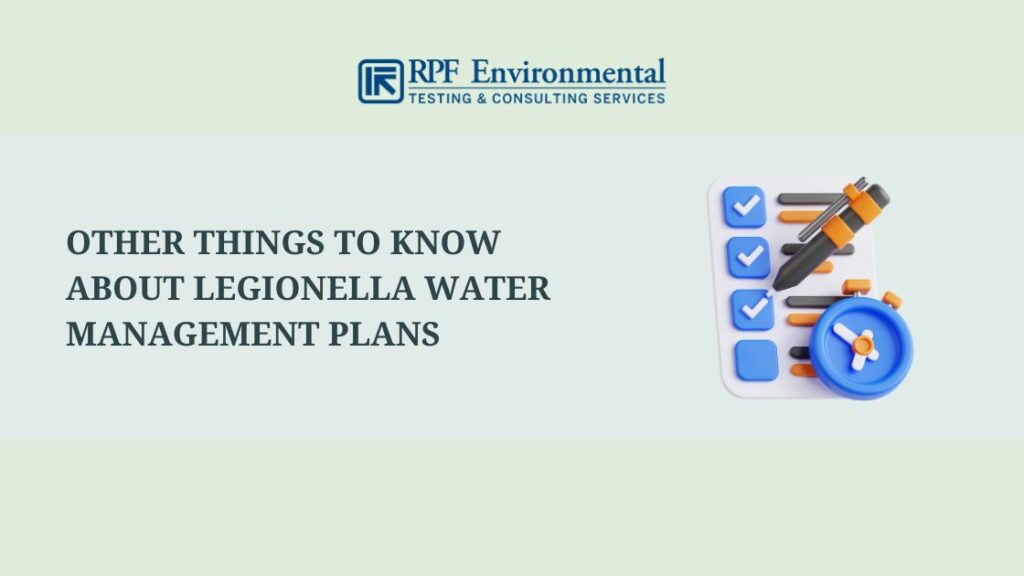
What Causes Legionella in the Water System?
Legionella can grow in your buildings when ideal conditions for the bacteria to survive are met. According to the CDC, internal factors that can lead to the growth of Legionella include:
- Biofilm growth on constantly moist surfaces
- Sediment and scale
- Fluctuations in water temperature (77°F – 113°F)
- Changes in water pressure
- Water stagnation
- Inadequate disinfectant
- pH (the ideal range is between 6.5 and 8.5 for disinfectants to work)
Other external factors include the following:
- Vibrations caused by construction activities that can dislodge Legionella into your water
- Water main breaks that cause sudden changes in water pressure
- Changes in the quality of municipal water that can lower disinfectant levels, increase sediment and turbidity, and lead to undesirable pH levels
What Is the Best Way to Prevent Legionnaires?
“There are no vaccines that can prevent Legionnaires’ disease. Instead, the key to preventing Legionnaires’ disease is to reduce the risk of Legionella growth and spread.”
– CDC, Legionella (Legionnaires’ Disease and Pontiac Fever)
Maintaining your water supply properly through an effective water management program is the best way to prevent Legionnaires’ disease.
How Often Should You Run Water to Prevent Legionella? How Long Do You Run Taps for Legionella Flushing?
Flush your water system when the building hasn’t been used for a long time (weeks or months) or when there are reductions in normal water use.
When flushing, the CDC recommends doing the following:
- Flush both hot and cold water in your sink faucets, showers, and other points of use
- Flush until you reach the maximum temperature of the hot water
- Minimize aerosol generation and splashing during flushing
Also, we recommend running water outlets and taps for at least five minutes weekly.
What Temperature Kills Legionella?
The ideal temperature for Legionella to grow ranges from 77°F to 113°F. However, take note that Legionella can still grow outside this range. Thus, setting your water heater at at least 120°F can help minimize Legionella growth. Hotter temperatures (130 – 140°F) can kill Legionella but can also cause scalding. Make sure that you follow anti-scald regulations in your area.
Also Read:
- How to Prevent Legionnaires Disease in the Home: Everything You Need to Know About Legionnaires’ Disease
- Tips to Avoid Legionnaires’ Disease
- How to Test Drinking Water for PFAS & What You Need to Know About PFAS in Drinking Water
- What You Need to Know About EPA’s Drinking Water Lead and Copper Rule in Schools
FAQs
Legionella water management plans involve:
– Identifying hazardous conditions in your water systems
– Establishing procedures on how to minimize the growth and spread of Legionella in your building
A few ways you can minimize Legionella growth in your pipes include:
– Keeping your pipe work direct and short (eliminate dead legs)
– Using pipe insulation to maintain water temperatures
– Installing thermostatic mixing valves close to fixtures
– Avoiding materials and devices that encourage Legionella growth (e.g. mechanically complex and low-flow fixtures)
– Maintaining your hot water temperature at the maximum temperature allowed by local or state regulations
Chlorine dioxide, chlorine, and monochloramine are among the popular chemical disinfectants used to control Legionella and other bacteria.
Conclusion
The best way to control the growth and spread of Legionella in your water systems is to develop and implement a water management program. You can train your own employees to ensure the creation and implementation of an effective water management plan. But, hiring licensed professionals outside will be greatly beneficial to the success of your program.
RPF Environmental has licensed environmental specialists and certified industrial hygienists who can guide you in controlling Legionella in your building. We also offer Legionella testing to help validate the effectiveness of your program. Book a consultation now!

